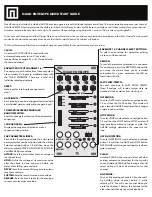
PTE-300-V
Sheet 32
4.2.1. INITIAL STATUS
When the unit is turned on, the following values and selections are made:
1. Output mode: voltage.
2. Selected range: 300 V.
3. Selected value: 00.00 V.
4. Output status: OFF.
5. Reference: Freq.
4.2.2. OUTPUT MODE SELECTION (V/I)
As mentioned before, the PTE-300-V can be used as a voltage or current source. When the unit is
turned on it will be in the current mode. The voltage output is achieved in the following way: press the
TAP V/I
key for more than 2 seconds. The display will change its units to A (Amps) and the output
range will automatically change to 0.33 A (150 V). The values selected from now on will be in amps.
To return to the voltage mode press the same key again for more than 2 seconds.
4.2.3. OUTPUT RANGE SELECTION
The following output ranges are available:
•
Voltage mode: 6.25 / 150 / 300 V.
•
Current mode: 0.33 / 8 A.
To select any of these ranges press the
TAP V/I
key. The display will automatically change. In case
we have selected a value and this is greater that the new selected range, the value will set to the
maximum value in the selected range.
The active range is that which has its corresponding LED lit.
4.2.4. REFERENCE SOURCE SELECTION
When the unit is turned on, it is synchronized to its own internal signal produced by the
IFG
. This is
indicated with the FREQ LED on. If you want to change this reference you must do the following:
1. Press the SYNC key. The unit will pass to the reference BUS-PTE, which is indicated by the
corresponding LED marked BUS. This implies that the reference is the BUS-PTE, with any
other unit of the PTE range. If the units are not interconnected (BUS-PTE is not connected or
there is no
Reference Master
selected) the LED indicator will flash slowly indicating that there
is no reference. If there is no reference in the BUS and the output is turned on, the unit will
synchronize automatically to the last valid reference (FREQ).
2. Press again the SYNC key. The unit will pass to the LINE reference, which is indicated by the
corresponding LED marked LINE. This implies that the reference is the main voltage supply.
3. Press again the SYNC key. The unit will pass to
External Reference
, which is indicated by the
corresponding LED marked EXT. This implies that the reference is now the signal connected to
the
External Phase Reference Input
, introduced in the taps
Ext. Phase Reference
. If there is no














































